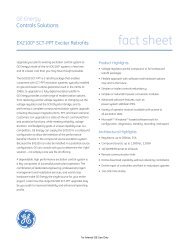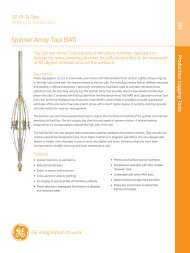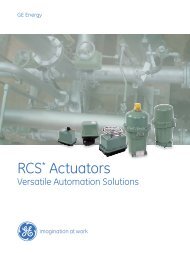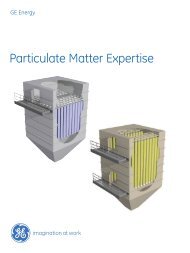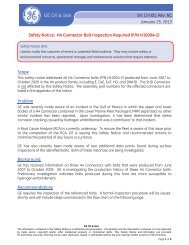Masoneilan SVI II AP Installation and Maintenance ... - GE Energy
Masoneilan SVI II AP Installation and Maintenance ... - GE Energy
Masoneilan SVI II AP Installation and Maintenance ... - GE Energy
Create successful ePaper yourself
Turn your PDF publications into a flip-book with our unique Google optimized e-Paper software.
<strong>GE</strong> Oil <strong>and</strong> Gas<br />
<strong>SVI</strong> <strong>II</strong> <strong>AP</strong> Instruction Manual<br />
HART H<strong>and</strong>held Communicator<br />
ValVue<br />
The HART h<strong>and</strong>held communicator is a universally available tool that provides all the<br />
accessibility of the local button <strong>and</strong> display. The HART tool has the functionality to upload<br />
<strong>and</strong> download configurations, enter alphanumeric messages <strong>and</strong> set the custom<br />
characteristic numerical parameters. The <strong>GE</strong> DPI620 is approved for Intrinsically Safe<br />
use in Hazardous Areas in accordance with <strong>SVI</strong> <strong>II</strong> <strong>AP</strong> approvals. See “HART<br />
Communications with Intrinsic Safety” on page 123 <strong>and</strong> “Wiring an <strong>SVI</strong> <strong>II</strong> <strong>AP</strong>” on<br />
page 105 for additional information concerning this device.<br />
ValVue combines the power of the PC with the features of the <strong>SVI</strong> <strong>II</strong> <strong>AP</strong> for ease of use<br />
<strong>and</strong> automation of positioner operation <strong>and</strong> full access to all data. ValVue Lite is provided<br />
with all <strong>SVI</strong> <strong>II</strong> <strong>AP</strong> positioners <strong>and</strong> is recommended for set up, service <strong>and</strong> maintenance<br />
where a PC or laptop is permitted. See “Configuring <strong>and</strong> Calibrating with ValVue” on<br />
page 103 for further information.<br />
Pushbuttons <strong>and</strong> Local Display<br />
This section covers the optional local interface consisting of the LCD alphanumeric<br />
display <strong>and</strong> pushbuttons. Operation of the <strong>SVI</strong> <strong>II</strong> <strong>AP</strong> Digital Valve Positioner as a local<br />
device is controlled through the optional device-mounted pushbuttons <strong>and</strong> digital display,<br />
shown in Figure 51 on page 73. Using the display you can read the input signal, valve<br />
position, <strong>and</strong> actuator pressure. The display sequences from one variable to the next<br />
every 1.5 seconds.<br />
Using the pushbuttons you can exit from operating mode at any time <strong>and</strong> step through a<br />
menu structure to perform a wide range of manual operation, calibration, configuration,<br />
<strong>and</strong> monitoring functions that are described later in this section. ValVue is used to perform<br />
all diagnostics functions. The pushbuttons do not support diagnostics functions.<br />
The <strong>SVI</strong> <strong>II</strong> <strong>AP</strong> has two operational modes: Normal (normal operating mode) <strong>and</strong> Manual<br />
(manual operating mode) <strong>and</strong> two setup modes, Configuration <strong>and</strong> Calibration. The <strong>SVI</strong> <strong>II</strong><br />
<strong>AP</strong> also has two modes for h<strong>and</strong>ling of faults <strong>and</strong> power-up: Reset <strong>and</strong> Failsafe. When<br />
commissioning or checking a control valve with <strong>SVI</strong> <strong>II</strong> <strong>AP</strong> fully installed the following steps<br />
are recommended:<br />
1. Change mode to Manual mode.<br />
2. Examine <strong>and</strong> adjust all Configuration items.<br />
3. Enter Calibration mode.<br />
4. Run Stops to automatically calibrate stroke.<br />
5. Run Auto Tune to set dynamic response.<br />
6. Examine the device status.<br />
7. Introduce manual set point changes to verify dynamic performance.<br />
72








